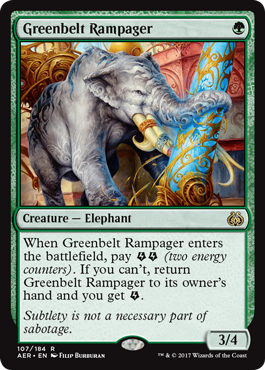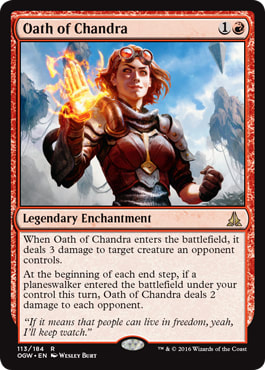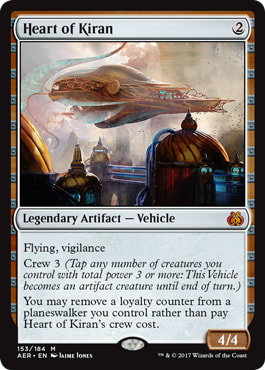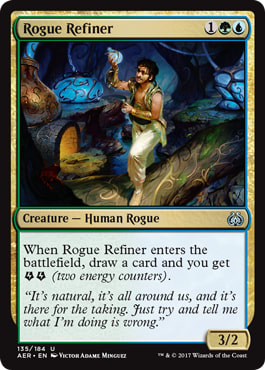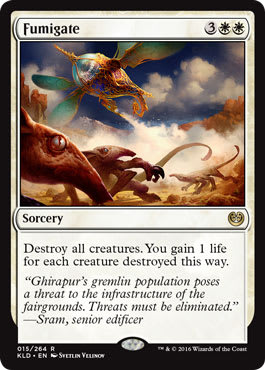With the upcoming Grand Prix in New Jersey showcasing Standard, alongside recent RPTQ results and the omnipresent PPTQs and SCG events, it seems only right and proper to document my recent journey through Standard’s various contenders and discuss what others are doing wrong in their lists. While Modern is busy trying to get out from under Death’s looming Shadow, Standard is facing a few different monsters in Four-Color Saheeli, Mardu Vehicles, and B/G Constrictor. The clash of these titans, as it were, defines what we can expect out of Standard tournaments week-in and week-out. Some might classify this format as stale, boring, or otherwise infertile with regards to innovation. I am not one of those people, though. Far from being a midrange mirror-centric format, Standard has not yet even settled on the best builds of these three major players, which offers the enterprising metagame analyst a ton of opportunity to play unexpected cards to great success. In formats like these, individual cards rapidly spike and collapse in terms of their potency, because their power is so dependent on being new and unexpected. Even in ostensibly hostile environments, innovation can thrive, and in all three major players there are examples of positioning jukes (that is, going bigger or smaller), as well as individual threat choices (think Planeswalkers vs. Skysovereign, Consul Flagship vs. Elder Deep-Fiend in Saheeli Combo) that bear witness to the diversity within the big players of the format.
Let’s start with the various options when it comes to the current third wheel of the format, the macro-archetype of B/G Constrictor. The trends are a tiny bit outdated, but there is still a ton of wisdom to be gained from analyzing the threat choices and positioning of various builds of the deck.
To start, the Greenbelt Rampager version from the Pro Tour, which went 9-1 in the hands of Ken Yukuhiro:
B/G Constrictor ? Aether Revolt Standard | Ken Yukuhiro, Pro Tour Aether Revolt
- Creatures (28)
- 4 Glint-Sleeve Siphoner
- 4 Greenbelt Rampager
- 4 Longtusk Cub
- 4 Rishkar, Peema Renegade
- 4 Verdurous Gearhulk
- 4 Walking Ballista
- 4 Winding Constrictor
- Instants (5)
- 2 Grasp of Darkness
- 3 Fatal Push
- Sorceries (4)
- 4 Attune with Aether
- Artifacts (2)
- 2 Aethersphere Harvester
- Lands (21)
- 4 Swamp
- 6 Forest
- 3 Hissing Quagmire
- 4 Aether Hub
- 4 Blooming Marsh
Ken’s version was great for a semi-open metagame, where he expected to beat down against unknown opponents and but the pressure on them to answer his undercosted threats. When in doubt, cheaper is better, especially in Game 1. Considering that Mardu Vehicles turned out to be a key matchup at the Pro Tour, Ken’s Greenbelt Rampagers looked stellar, as they enabled two-spell turns as early as turn three. And as we all know, two-spell turns are the best way to turn the corner against an aggro deck. Post-sideboard, he had the option of playing Lifecrafter's Bestiary against control, as well as haymakers like Skysovereign, Consul Flagship and Ob Nixilis Reignited. Both Ken and Brad Nelson correctly identified Lifecrafter's Bestiary as the best unanswerable engine for slogging through grindy control matchups, which makes a ton of sense. Many Jeskai Saheeli decks would overload on removal, sweepers, and Planeswalkers going into Game 2 while shedding some of their counterspells or combo pieces, which makes a card like Bestiary absolutely game-breaking. Combine that with light disruption in Transgress the Mind, and you have a solid grindy gameplan with a bunch of creatures that wouldn’t ordinarily seem suited to battling into the late stages of a game. When the aggro deck draws more cards than the control deck, you know you’ve got a pretty special sideboard plan.
But Ken’s deck, while well positioned for a field of Jeskai Saheeli, Mardu Vehicles, and random control decks, quickly fell out of favor as Brad Nelson sang the praises of his version of midrange B/G. Blame Brad’s unique soapbox via his weekly articles on SCG, but the following list became more standardized as Brad’s pronouncements shaped the metagame for the next few weeks.
B/G Midrange ? Aether Revolt Standard | Brad Nelson
- Creatures (27)
- 2 Gonti, Lord of Luxury
- 2 Rishkar, Peema Renegade
- 3 Tireless Tracker
- 4 Glint-Sleeve Siphoner
- 4 Servant of the Conduit
- 4 Verdurous Gearhulk
- 4 Walking Ballista
- 4 Winding Constrictor
- Instants (6)
- 1 Murder
- 2 Fatal Push
- 3 Grasp of Darkness
- Artifacts (3)
- 3 Aethersphere Harvester
- Lands (24)
- 5 Forest
- 7 Swamp
- 4 Aether Hub
- 4 Blooming Marsh
- 4 Hissing Quagmire
- Sideboard (15)
- 2 Appetite for the Unnatural
- 2 Fatal Push
- 1 Gonti, Lord of Luxury
- 3 Lifecrafter's Bestiary
- 1 Ob Nixilis Reignited
- 3 To the Slaughter
- 3 Transgress the Mind
What started with a love affair with Gonti morphed into an ever-increasing arms race of midrange brinksmanship. Tireless Tracker, heavier removal suites, cutting down on Rishkar, Peema Renegade, eventually losing Glint-Sleeve Siphoner and Longtusk Cub, morphing into heavier Delirium builds or moving back to Nissa, Voice of Zendikar, the deck had so many options at every step of the curve that it was impossible to nail down a specific stock list. Personally, I enjoyed the Harnessed Lightning version of the deck with a light splash of Red, but the Four-Color Saheeli builds began evolving with one innocuous removal spell that started the ascent of that deck and subsequent descent of the Winding Constrictor archetype.
Oath of Chandra, in retrospect, seems almost tailor-made to dismantle the best Winding Constrictor draws. On the draw, the Four-Color Saheeli player can cleanly answer the Snake, while having the residual enchantment sit around for a Felidar Guardian to blink two turns down the road, answering a Servant of the Conduit, Walking Ballista, Rishkar, Tireless Tracker, or second Winding Constrictor while simultaneously presenting half of the Saheeli combo. The combination of realized tempo gained from the removal spell itself and the false tempo gained from the looming threat of an instant win on the fifth turn absolutely crushes most B/G draws. Four-Color Saheeli shifted from being behind to most Winding Constrictor-heavy draws to being way ahead with this new addition, and the shift away from cards like Cloudblazer to removal-and-card-advantage in one neat package in Chandra herself contributed even more to an unexpected reversal in the matchup.
Again, to no one’s surprise, Brad Nelson has painted himself as the Standard Metagame Whisperer, with a recent expose on Four-Color Saheeli showing off the following (now-stock) decklist:
Four-Color Saheeli ? Aether Revolt Standard | Brad Nelson
- Creatures (16)
- 4 Felidar Guardian
- 4 Rogue Refiner
- 4 Servant of the Conduit
- 4 Whirler Virtuoso
- Planeswalkers (8)
- 1 Tamiyo, Field Researcher
- 3 Chandra, Torch of Defiance
- 4 Saheeli Rai
- Instants (4)
- 4 Harnessed Lightning
- Sorceries (4)
- 4 Attune with Aether
- Enchantments (7)
- 3 Oath of Chandra
- 4 Oath of Nissa
- Lands (21)
- 1 Island
- 1 Mountain
- 1 Plains
- 5 Forest
- 1 Evolving Wilds
- 2 Game Trail
- 2 Spirebluff Canal
- 4 Aether Hub
- 4 Botanical Sanctum
- Sideboard (15)
- 2 Tireless Tracker
- 2 Authority of the Consuls
- 1 Dispel
- 2 Natural State
- 3 Negate
- 1 Tamiyo, Field Researcher
- 2 Baral's Expertise
- 2 Release the Gremlins
Now, there’s a lot to like about Brad’s list here. The numbers are clean, the cards all seem to serve a purpose, and the Planeswalkers are plentiful. Everyone loves Planeswalkers, right? But more than the cards that are there, a savvy metagame analyst needs to look at the cards that aren’t there. A number of once-celebrated pieces of the deck, like Elder Deep-Fiend and Aetherworks Marvel, have hit the bench. Brad chose to play more like a fair midrange deck with a backdoor combo than a combo deck with a number of random bodies to hold the fort and buy time, which is admirable in that it gave the deck a great matchup against the once-king of the format, B/G Constrictor. It’s this list that piqued my interest in Standard again, that got me off of my complacence with the Jund Constrictor midrange deck and back into the lab. The lab, in this case, was MTGO, and the common enemies on there turned out to be the mirror match, Temur Dynavolt, and (of course) Mardu Vehicles of all stripes.
Of course, I immediately started tinkering with the numbers. Chandra, Torch of Defiance was underwhelming against Mardu Vehicles, so one Chandra got shaved, alongside one of the Whirler Virtuosos. I didn’t, and still don’t understand the appeal of four of that card. Additional copies are so incredibly redundant that I can’t in good conscience recommend a full set of Virtuosos. Brad mentioned a build with three copies of Heart of Kiran as additional high-impact, low-cost cards, so I decided to give those a shot. As testing continued, I kept getting flooded with the deck, so against basically every Magic instinct I’ve ever learned, I shaved a land. Then, another. At just nineteen lands (alongside four Attune with Aether, four Oath of Nissa, and four Servant of the Conduit), this deck still rarely got manascrewed, but I noticed a lower proportion of games in which I ran out of gas in the midgame. Oath of Nissa already hits only lands in a significant percentage of its appearances, so there was little problem with relying on it more as a land to enable you to cast your powerful spells than as a card to hit your powerful spells in its own right. The deck began to look more like a Legacy deck, which is always a great sign, so the brewing continued with a bit of retooling of the deck’s removal suite. Oddly enough, despite Oath of Chandra’s obvious power against B/G Winding Constrictor, it barely pulls its weight against a deck as punishing as Mardu Vehicles. To beat a deck packing Thalia, Heretic Cathar and Toolcraft Exemplar, the go-to card switched back to good old reliable Shock. That’s when the Heart of Kirans came along and really got the party going.
Heart of Kiran is interesting in Four-Color Saheeli. Of course, with no Toolcraft Exemplars or Scrapheap Scroungers, it’s going to be slightly harder to crew the card with a cheap creature. On the other hand, Rogue Refiner does a decent job of crewing with his incidental third point of power. The beauty here is with Saheeli Rai. Saheeli isn’t trying to use her ultimate in this deck; rather, we’re looking to filter our draws, do a little incidental damage to our opponent, threaten a combo, and maybe enable a quick free card off of a Rogue Refiner copy. She’s perfect for Heart of Kiran, almost as perfect as she is for Felidar Guardian. Now, though, when you’re on the draw in the Saheeli mirror, a turn-two Heart of Kiran is the dream. It protects you from Saheeli from the opponent, because who in their right mind would cast a naked Saheeli into an opposing Heart of Kiran!? You could fire back with either your own Saheeli or a Rogue Refiner and completely steal their third turn from them, while simultaneously threatening your own combo the very next turn!
There’s no card in Standard that offers that kind of protection, and most opponents will have no recourse but to play their own Rogue Refiner or Whirler Virtuoso on their third turn, dissipating the advantage they got from being on the play. Now, because you’re a patient Magic player, you’d rather not dump your Saheeli on the table if they cast Rogue Refiner. You’d prefer not to open yourself up to an attack from the Refiner combined with a Harnessed Lightning to undo two turns of work with one removal spell. Nor would you want to let your Saheeli go to one loyalty from the Refiner hit, because then that sandbagged Saheeli in their hand would be able to finish yours off. Instead, you’d prefer to use your third turn casting a Rogue Refiner, Servant of the Conduit, or Whirler Virtuoso of your own, setting yourself up for a longer game. The great thing about this, though, is that your Heart of Kiran basically permanently presents a threat to any Planeswalkers your opponent might try to dump on the table, while protecting your own. For 2 mana, there’s not much more you could ask of a card.
Okay, okay, I’ll stop teasing you all and share my current (as of this writing) list for Four-Color Heart Saheeli:
Four-Color Heart Saheeli ? Aether Revolt Standard | Ben Friedman
- Creatures (15)
- 3 Whirler Virtuoso
- 4 Felidar Guardian
- 4 Rogue Refiner
- 4 Servant of the Conduit
- Planeswalkers (8)
- 2 Chandra, Torch of Defiance
- 2 Tamiyo, Field Researcher
- 4 Saheeli Rai
- Instants (6)
- 2 Shock
- 4 Harnessed Lightning
- Sorceries (4)
- 4 Attune with Aether
- Enchantments (5)
- 1 Oath of Chandra
- 4 Oath of Nissa
- Artifacts (3)
- 3 Heart of Kiran
- Lands (19)
- 1 Island
- 1 Mountain
- 1 Plains
- 4 Forest
- 2 Game Trail
- 2 Spirebluff Canal
- 4 Aether Hub
- 4 Botanical Sanctum
- Sideboard (15)
- 3 Fevered Visions
- 2 Authority of the Consuls
- 1 Dispel
- 2 Natural State
- 3 Negate
- 2 Baral's Expertise
- 2 Release the Gremlins
The sideboard Fevered Visions over the Tireless Trackers are an innovation I find fascinating, which came to me via a decklist from Zan Syed. Visions is excellent when your opponent is prepared for Trackers, because while they look foolish with a ton of Harnessed Lightnings or Grasp of Darkness, you watch them sputter and choke on the incidental damage from this amazing Howling Mine variant. Additionally, the card keeps you well-gassed in order to prevent them from gaining meaningful traction on the battlefield. When two Visions get in play simultaneously, though, watch out. Your opponent ends up on a very, very short clock.
Now, as for the elephant in the room, Mardu Vehicles, we see a deck that has exhibited the widest array of contortions in order to maintain its position in the top tier of the metagame. From a deck featuring maindeck Inventor's Apprentice and associated hyper-aggressive starts, to a controlling Planeswalker-based midrange deck, Scrapheap Scrounger and Heart of Kiran have absolutely taken on the world and lived to tell the tale. The beautiful thing about this deck is how most folks wrote it off completely in the early stages of the format, believing the presence of Winding Constrictor and Walking Ballista to be too difficult for an aggressive deck to beat. Of course, the Mardu decks took the Pro Tour by storm, with six out of the top eight and all four of the top four spots going to the aggressive menace. Then, just when the Constrictor decks seemed poised to squeeze the life out of Toolcraft Exemplar, the deck twisted and showed off an amazing transformational sideboard plan at Grand Prix Utrecht, turning into an Oath-heavy Mardu Superfriends deck right as the opponent boarded into a pile of cheap artifact removal. Here’s the winning list from the recent Magic Online Championships, won by Josh Utter-Leyton himself:
Mardu Vehicles ? Aether Revolt Standard | Josh Utter-Leyton
- Creatures (18)
- 2 Thalia, Heretic Cathar
- 4 Scrapheap Scrounger
- 4 Thraben Inspector
- 4 Toolcraft Exemplar
- 4 Walking Ballista
- Planeswalkers (4)
- 4 Gideon, Ally of Zendikar
- Instants (8)
- 4 Fatal Push
- 4 Unlicensed Disintegration
- Artifacts (7)
- 3 Aethersphere Harvester
- 4 Heart of Kiran
- Lands (23)
- 3 Plains
- 3 Swamp
- 1 Needle Spires
- 4 Aether Hub
- 4 Concealed Courtyard
- 4 Inspiring Vantage
- 4 Spire of Industry
- Sideboard (15)
- 1 Anguished Unmaking
- 1 Archangel Avacyn
- 1 Oath of Chandra
- 3 Oath of Liliana
- 1 Nahiri, the Harbinger
- 1 Ob Nixilis Reignited
- 2 Fumigate
- 2 Painful Truths
- 3 Release the Gremlins
Fumigate in the Toolcraft Exemplar deck . . . Well, I never! To beat B/G, the deck turned into a board-control midrange deck, with removal and card advantage aplenty. Now, the deck is a bit slower than before (losing Veteran Motorist for Walking Ballista will do that to you, for sure) but it’s got a ton of hate pieces for the Saheeli Combo as well as a great transformative sideboard plan for the semi-mirror and B/G. It’s a genius and unexpected twist that no one really saw coming, but the flexible and powerful Walking Ballista can allow otherwise-unthinkable transformations to see the light of day. The next step, of course, is making the control plan the maindeck plan while sideboarding down into a more aggressive deck once the opponent cuts much of their cheap removal. Additionally, the eternal cycle between threats and answers continues with narrow cards like Release the Gremlins going from unplayable to amazing in the span of a few weeks. Mark my words, though, Release the Gremlins is poised to fall from grace just as soon as the preferred threats switch from Skysovereign, Consul Flagship, Cultivator's Caravan, and Aethersphere Harvester to Archangel Avacyn and Ob Nixilis Reignited. I would not be at all surprised to see a Mardu list with two or three maindeck Archangel Avacyn take the tournament by storm this coming weekend, simply because that card lines up so well against the vast majority of removal in the mirror match.
And therein lies the beauty in this Standard format. The threats are powerful but profitably answered, and the answers are narrow but potentially backbreaking. This leads to a robust metagame where aggro decks can consider anything from Archangel Avacyn to Ob Nixilis to Skysovereign to Fumigate to Nahiri, the Harbinger, where midrange decks seamlessly slide from Greenbelt Rampager to Gonti, Lord of Luxury, and where the premier combo deck of the format has its choice between Shock, Oath of Chandra, or Heart of Kiran for low-cost cards, with Chandra, Tamiyo, Elder Deep-Fiend, Cloudblazer, and even Aetherworks Marvel for its high-end threats. Not to mention the sideboard levels, where Fevered Visions and Tireless Tracker compete for the same spots, and Mardu can move anywhere along the continuum from twelve 1-drop creatures to twelve 4- and 5-drop Planeswalkers. The games may often feel like one side didn’t come to play the same format, but there is enough to think about in this Standard format that no one could ever fully solve it. I mean, who would have thought that I’d be cutting to 19 lands in my combo deck of choice while boarding in Negate against the Toolcraft Exemplar/Scrapheap Scrounger deck? This is not the most diverse Standard format we’ve ever seen, but there are a ton of lessons out there waiting for you to come and uncover them. Get on it, and I’ll see you all in New Jersey!













